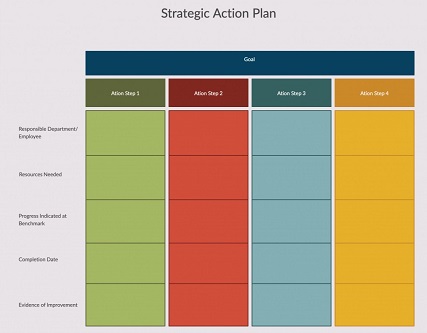Know How to write an action plan in 2024
The term ‘action plan’ is used within project management to describe a complete breakdown of a project or task. A well-written action plan will include the following:
Every step is important
- Target to be achieved at each stage and overall
- Responsibilities of each person within the plan
- Budget for each section of the plan, as well as overall cost estimates
Breakdown of time limit for each section
While a to-do list or overall goal may give generalized information about what a project needs, an action plan goes into much more detail, meaning that everyone involved in a project has a task in one document. I will have all the information needed to complete it. ,
Why are action plans useful?
Action plans are very useful to enable project managers to see what needs to be done within the long-term goal and to delegate tasks effectively.
A clear, concise work plan will show everyone involved their responsibilities and when they need to be completed, providing insight into the team effort required for a project.
As each task within an action plan will have its requirements and deadlines, it also helps to break down a large project into smaller, more manageable sections.
This can motivate team members who might otherwise feel overwhelmed by just one big task that needs more detail that would be included in an action plan.
Using an action plan can also be very helpful when staff members are executing parts of a project in different departments or areas of a business.
Each person will know what they are doing and how their actions fit into the bigger picture. They will also be able to manage their time better because they will know when a goal needs their input.
How to write an action plan
There are many different ways to write an action plan. The following points and examples outline useful things to include, which will help you decide how to write your action plan that best suits your individual needs.
Clearly define your end goal
You should be clear about the purpose of the plan. This way, everyone reading the action plan will know what they are working towards.
For example, if an action plan is written to complete a project, this should be relayed in the title or first points of the plan:
Action Plan – To create a new website for ABC with updated content.
Sometimes it’s also useful to note where the plan fits into the rest of the company’s objectives. This can be about an annual or quarterly plan or other long-term goals.
Break down the process into different steps and periods
This is especially important if the work plan is written for a particularly lengthy project or requires input from several different departments or outside agencies.
It can be helpful to brainstorm everything needed to complete the project so that you can see the steps that need to be accomplished.
It can also help you see parts of the project that can be grouped or performed by the same person.
Advantages of this approach:
People can easily find their roles within the plan
Small tasks can motivate people because they will seem less daunting.
Setting smaller time goals will make it easier to see if a project is on schedule.
Be specific about the resources needed at each stage.
If you know that a section needs assistance from an outside agency, ensure this is set out in the work plan.
Similarly, if a specific type of equipment or technology is required, it should be added to the plan’s relevant section.
For example:
A project to update a company’s website may involve hiring a copywriter to update written information.
Making sure this is specified at the beginning of the writing phase of the website project will ensure that the appropriate person sees it to recruit the writer.
Or:
Large construction projects will involve many smaller sections creating the finished result. Some of these will require the use of special equipment that may need to be obtained.
Specifying this in the work plan will save unnecessarily wasted time because employees will know what they need before starting that particular project section.
Specify who contributes what, how, and when
Some work plans will require the entire team to be available at all times. Others will require specialized staff members for short periods.
It’s important to note exactly who you need and when so that anyone who isn’t needed for the entire project can schedule their time and be available when needed.
For example:
During a project to create a new website, outside agencies may be used, such as content writers and graphic designers.
These individuals will not be needed throughout the project, so it is important to let them know when their input is needed so that their schedules align with yours and that misinformation about dates will not cause any delays.
Specify objectives for each section of the project
By ensuring that the objectives for each section are specified, team members will know if they are doing the right thing and working to meet the brief.
This will save time and avoid mistakes because everyone knows exactly what they need to do to complete their particular project section.
For example:
If the goal of the section is to conduct market research, the objective would be to find out what the consumer wants from a product.
Suppose the division’s goal is to reduce the time between customer ordering and product delivery. In that case, the objective may be to hire more employees to fulfill orders or to provide current staff members with the opportunity to work overtime hours.
If the section aims to write new content for a company website, the objective will specify which pages must be completed and the required information and word count.
Multiple interim deadlines are better than one final deadline
Breaking a project into smaller, bite-sized chunks will make it feel more manageable and less overwhelming to the staff involved.
Instead of seeing one large and perhaps daunting task, they will see a series of smaller tasks that can be systematically completed until the result is met.
Another reason to break a large project into smaller sections with interim deadlines is that it gives staff members who are not needed full time to schedule other tasks and accomplish more.
If only there was a big deadline, they might clear their diary for the project and only do what’s needed for a week or two, meaning other tasks needlessly wait.
For example:
If you know you will only need a graphic designer’s work for two weeks in the middle of a six-week project, specifying this on the work plan will allow them to schedule their time and complete other tasks when They won’t be needed, increasing overall productivity.
Third, creating shorter deadlines will help keep the overall project on target.
If team members know they only have a limited amount of time to complete one section before starting the next, they are more likely to work at a pace that ensures that their section time is met. But it’s over.
Sometimes, this can mean that they finish ahead of schedule, and this ‘gained time’ can be used when another section of the project is overtaken, Essentially ensuring that the project can be completed on time even with unforeseen delays.
Consider the need for software and make sure everyone has access.
This can be software needed to access the work plan or something needed during the project.
Everyone involved in the project must know if they need to access a specific website or app — you don’t want half your team working in Google Docs and the other in Basecamp.
Checking this at the start of a project can help avoid unnecessary delays along the line where someone might miss a piece of information because they need access to the relevant software.
This is especially important if sections of the project will require input from outside agencies, as they may not automatically have access to the same documents that internal team members would have.
For example:
Suppose you typically communicate with your team via Zoom or Microsoft Teams. In that case, everyone must be included in relevant groups and meetings as well as in email briefs sent.
Present your plan well and easy to read
People are less likely to read a long, drawn-out action plan when they are busy and have other things they need to focus on.
This means ensuring the plan is easy to read and presented effectively; people can quickly look at it, figure out what they need to do, and get started quickly. Should be done, if it is dense and full of redundancy.
Consider formatting the action plan as bullet points, a flow chart, or a table specifying each project section.
These formats are much easier to read than a detailed, complex Word document and will encourage you to keep information brief and to the point.
Top Tips for Writing an Action Plan
- be concise
- note down everything you need to do
- Make sure the purpose of each project section is clear, so everyone knows what they need to do to complete their tasks.
- Keep time goals realistic.
- Make sure everyone has or will have everything they will need
- Remember to mark things as done once you’re done to avoid accidental repetition
- Regularly review how well the project is following the plan and whether changes need to be made
Final Thoughts
It’s easy to underestimate the value an action plan can add to your project. A well-written action plan can help you set realistic goals and work more efficiently.
Having smaller projects within the work plan, in addition to an overall goal, will help team members know exactly what they need to do and when leading to better time management in their other projects and the work plan. Would be relevant to
A good action plan can also highlight strengths and weaknesses within a team or a project’s approach, Showing where improvements need to be made and making it easy to see which approach works best. This is beneficial in the future when new projects are started, and further action plans need to be written.





